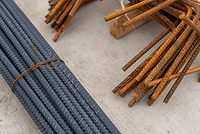Resilient Coatings for Critical Infrastructure
Meeting the Demand Surge

There are a variety of factors driving the ongoing shortage of transformers, including manufacturing growth, intense heatwaves, electrification, and widespread adoption of renewable energy sources, all requiring an expansion of the energy grid to support new equipment and transformers. But demand will only accelerate with the boom in Artificial Intelligence (AI) and the power needed to operate AI data centers.
According to a report by the International Energy Agency, global electricity demand is expected to rise at a faster rate over the next three years, growing by an average of 3.4% annually through 2026, driven in part to data center energy needs.
Transformer manufacturers have found it challenging to scale up production to meet the demand, putting an immense strain on the supply chain. Long wait times are now the norm with no signs of easing. Currently, lead times are between 115 to 130 weeks, on average.
The limited inventory of parts, along with aging infrastructure, poses risks to critical systems that power vital networks, such as hospitals, communication networks, water and waste management, and even military bases.
The U.S. Department of Commerce reports that the average age of transformers in use is 38 years—approaching the end of their expected lifespan—with 70% older than 25 years.
In light of the scarcity of new equipment, refurbishing and maintaining existing transformers has become crucial. Restoring and updating these components, including their exterior protection with high-quality industrial coatings, can help address the growing demand.
Although it might seem inconvenient to update coatings systems that have not yet failed, now may be an ideal time for manufacturers to reassess their protective technologies and consider newer, more effective solutions before a more widespread problem occurs.
A key part of this refurbishing process is updating the exterior protection, including sanding, priming and painting with a durable industrial coating engineered to defend against corrosion. This is important because outdated coatings systems may not be as durable, particularly under harsh weather conditions. This vulnerability can lead to significant power service disruptions and equipment failures, which can be life threatening, particularly in the current climate with rising temperatures worldwide.
Long-Term Corrosion Protection
When it comes to the metal components on a transformer, corrosion is public enemy number one.
Metal electrical equipment parts corrode for any number of reasons. Some factors include the intersection of two metals with different corrosion thresholds, or continuous or repeated exposure to high temperatures and humidity from decades in the field, damaging pH (acid) levels, electrolytes, chemicals and ultraviolet rays from sunlight.
Selecting the proper coating materials to help preserve power generators, transformers, switchgear and more is the first line of defense. The right coating system that offers durability and resilience at every layer of protection—from pretreatment through finish coat—can extend the service life of the part and reduce the risk of coatings-related equipment failures.
Getting Started: Reviewing Current Paint Specifications
While most electrical equipment has a minimum life expectancy of 20 years, many components are expected to survive 50 years or more. Harsh elements can accelerate corrosion and leave sensitive instrumentation vulnerable and potentially unreliable.
Unfortunately, many manufacturers still combine old “cut-and-paste” specifications that date back 20 to 30 years with current industry-standard regulatory requirements written by IEEE, UL, CSA and ASTM when painting and protecting new equipment.
On average, finished electrical components are composed of about 70% metal and 30% non-metal substrates, yet nearly 100% of electrical equipment manufacturers view painting metal as beyond their core competency. An average-sized switchgear manufacturer running 10 to 15 million square feet of coated metal through its facility is staking a lot of its reputation on work considered outside of their scope.
If the goal of an electrical equipment manufacturer is to build next-generation components that exceed performance mandates while protecting its brand reputation, paint specifications should be reviewed and updated regularly.
In addition to product scope and substrate type, manufacturers should consider the following when developing their specifications:
Coating Type
Coating manufacturers offer a variety of resin chemistries to improve resistance to corrosion and UV exposure, including epoxies, polyesters, urethanes and acrylics, as well as hybrid coatings, which incorporate a combination of resin chemistries. Each have their strengths and weaknesses.
For instance, epoxies are ideal for chemical resistance and mechanical properties, but are lacking in UV resistance and weatherability.
Polyesters, urethanes and acrylics all offer exceptional weathering characteristics, but each offers a different benefit, such as great physical properties for polyesters; chip, scuff and mar resistance for urethanes; and exceptional surface appearance for acrylics.
Product Codes
Electrical equipment producers should avoid using a specific paint manufacturer’s product code. Codes can be ambiguous or difficult to find, as they often change or may be unique to a specific customer. Instead, detail the specific coatings technology the equipment demands (pretreatment, liquid, powder or electrocoat); then detail the resin chemistry of the desired coating.
Color
Establishing and maintaining a standard color can be challenging. It is important to detail an acceptable range of color variation and use a proven and consistent method for determining that the color of a painted parts falls within specification.
Pantone, RAL, Munsell, and ANSI are color-cataloging systems commonly used for these purposes, although some equipment manufacturers choose to create their own in-house standards. Maintaining color standards is a whole separate topic, so it is best to work with a reputable paint manufacturer to understand the intricacies of creating a color standard and how to detail its parameters in the specification.
Gloss
Like color, the gloss range specification can have a big impact on a product’s finished appearance. It is important to provide a specific gloss range in a paint specification, as variations in gloss can cause the same color on a piece of equipment to appear as different shades.
Texture
In the electrical industry, some orange peel (minor paint dimpling) in the finish is considered preferable, as it tends to hide flaws and wear well over time. Regardless, standards for texture types and variation should be written into the paint specification.
Product Handling and Storage
Manufacturers suggest specific rules for handling and storage in their product data sheets, including an acceptable range of temperature exposures and fixed expiration dates to ensure inventory is properly rotated.
Performance
Regulatory standards such as UL or IEEE should be detailed in the paint specification. These standards are written to include a range of acceptable results for products undergoing laboratory-based performance tests, which have been agreed upon by the industry for their ability to mimic real-world performance environments.
Ensuring Longevity: Effective Performance Testing for Coating Systems
While many coatings systems are sufficiently robust to pass industry-accepted performance tests, they can fail in the field because the real-world conditions are often more challenging.
For that reason, it is critical to include the tests that most accurately reflect a product’s ability to fulfill a warranty or an expected service life in the paint specification. For example, does a specific impact test predict paint chipping once installed in the field? Or does an accelerated weathering test depict the real-world color fade or breakdown of a coating?
Performance testing must also correspond to field troubleshooting. If a coating fails in the field, correlating the failure to a specific testing method will enable the equipment and paint manufacturers to identify the reason for the failure, which can lead to quicker corrective actions.
Some of the most common performance tests written into an electrical equipment paint specification are detailed below:
Salt Spray
This is the most commonly specified test in the electrical industry. UL1332 requires 600 hours of salt-spray exposure for electrical enclosures and switchgear. Many transformers require between 1,000 and 2,000 hours of exposure.
Ultraviolet Accelerated Weather Testing (QUV)
In this test, coated panels are exposed to ultraviolet (UV) light of varying types, resulting in “maintain X% specific gloss level after X number of hours” rules as detailed in a specification. These tests are designed to predict how a coating will fade outdoors over time.
Simulated Corrosive Atmospheric Breakdown (SCAB)
In this test protocol, painted panels are scribed, then cycled through exposure conditions produced in the following environments: an oven, a freezer, immersion in an NaCl solution, room temperature, high humidity. The IEEE test for SCAB required 15 total cycles with prescribed times in each area. This testing is designed to predict how well a coating will maintain its integrity when subjected to a succession of regular and extreme performance environments.
Humidity Testing
During this test, painted panels are typically placed in a chamber for 1,000 hours, then examined for evidence of blistering or softening. This testing is designed to predict how well a coating resists water.
Impact Resistance
For this test, panels are exposed to an array of impact hazards, measured according to pounds. Transformers are typically tested at 80 pounds of impact. This testing is designed to predict how well a coating will resist force from an object, such as a tool or machine. It also may predict a coating’s resistance to chipping when a bolt or other fastener is tightened onto its surface.
Cross Hatch Adhesion
In this test, a tool is used to cut a lattice pattern into a metal substrate. A quick pass/fail rating is assessed to the full coating system to gauge its ability to adhere to a substrate.
Gravelometer
Road gravel is air-blasted into coated panels, which are then placed into a salt-spray chamber to assess the corrosion resistance of the exposed parts. This test is designed to predict a coating’s chip resistance and ability to withstand road gravel.
Other tests that are occasionally used and built into specifications for electrical equipment include:
Pencil hardness
During this test, a pencil is pressed through the surface of a coating to measure its adhesive strength.
Adhesion Testing
This test method involves applying tape across a painted surface in a cross-cut method, then removing it to determine how effectively the paint sticks to the surface.
There also are many types of chemical tests, including an insulating fluids test to determine a coating system’s ability to resist exposure to certain types of chemicals.
Optimizing Coating Technology: Balancing Durability and Sustainability
Is your current coating technology utilizing the latest coatings advancements and the most sustainable options?
Liquid coatings use solvents or water and are applied to pretreated metal with electrostatic spray, dipping and other conventional methods before being air-dried or force-cured.
When used as part of an integrated primer, pretreatment and topcoat system, liquid coatings offer exceptional resistance to corrosion and chemicals, excellent sag resistance and strong adhesion. The newer product offerings in waterborne liquid technologies can offer a more sustainable option as part of an integrated coating layer.
Powder coatings are formulated for applications that require the ultimate combination of corrosion resistance, weathering performance and operational attributes. These coatings are typically formulated with specific resins combined to provide excellent corrosion and chemical resistance, as well as all-around application versatility.
Since powder coatings are made without solvents, they generate virtually no volatile organic compound (VOC) emissions, which can help to achieve environmental compliance and reduce material usage, energy consumption and maintenance costs thanks to a first-pass transfer rate of up to 85%.
New Breakthrough in Zinc-Rich Powder Primer Protection
Due to their advantages in sustainability, edge coverage and durability, powder technologies are growing in global prominence, including zinc-rich powder primers. While zinc is renowned for its corrosive fighting properties, its density poses challenges during application.
Recently, scientists achieved a breakthrough by formulating a zinc-rich primer with optimized zinc content. This patent-pending innovation boasts higher transfer efficiency, thanks to its lower specific gravity compared to standard zinc-rich primers (2.0 vs. 3.6). The reduced density makes it easier to apply, achieving an impressive 85% transfer efficiency. Although it contains less zinc by volume than traditional zinc-rich primers, it meets rigorous ISO C5 corrosivity standards, making it suitable for high-humidity and aggressive environments.
This well-balanced primer offers exceptional edge, face, and scribe corrosion resistance, semi-conductivity, and excellent adhesion on both smooth and blasted steel. Its robust bond withstands peeling, chipping, and degradation. In lab testing, the primer even surpassed 10,000 hours of salt spray performance on blasted steel.
Key Takeaways
When creating a paint specification, it is critical to correlate a component’s expected operating environment and service life to the testing methodology that most rigorously replicates the performance challenges it will face. Not only will this help to ensure that a product performs reliably throughout its lifetime; it may also lessen overall maintenance requirements.
Equipment manufacturers should evaluate their paint specifications on a regular schedule to ensure that they always incorporate the most targeted and technologically advanced coating systems and testing methodologies for their specific application.
They may also want to consider partnering with paint and pretreatment suppliers in the design process as early as possible, preferably with a proven coatings company that can offer both pretreatment and paint capabilities as an integrated package.
Integrated, full-service coatings suppliers typically have a deep understanding of the coatings process from start to finish, along with a wide range of products and resin chemistries that have been tested according to industry-standard criteria.
These coatings suppliers can act as a partner in identifying potential vulnerabilities to corrosion and help customers to select the best products to prevent it. Most integrated coatings suppliers also have dedicated lab resources, which enables them to recommend the best test methodologies to measure a product’s potential service life and troubleshoot general coatings-related production problems.
Looking for a reprint of this article?
From high-res PDFs to custom plaques, order your copy today!






